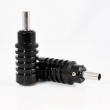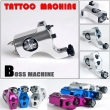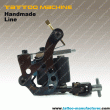Another tattoo machines was developed in 1970 by the german tattoo artists H.H. "Samy" Streckenbach (1929-2001) and Manfred Kohrs.
[edit] Dyes and pigments
Main article: Tattoo ink
Early tattoo inks were obtained directly from nature and were extremely limited in pigment variety. Today, an almost unlimited number of colors and shades of tattoo ink are mass-produced and sold to parlors worldwide. Tattoo artists commonly mix these inks to create their own unique pigments.
A wide range of dyes and pigments can be used in tattoos, from inorganic materials like titanium dioxide and iron oxides to carbon black, azo dyes, and acridine, quinoline, phthalocyanine and naphthol derivates, dyes made from ash, and other mixtures. Iron oxide pigments are used in greater extent in cosmetic tattooing.
Modern tattooing inks are carbon based pigments that have uses outside of commercial tattoo applications. In 2005 at Northern Arizona University a study characterized the makeup of tattoo inks (Finley-Jones and Wagner). The FDA expects local authorities to legislate and test tattoo pigments and inks made for the use of permanent cosmetics. In California, the state prohibits certain ingredients and pursues companies who fail to notify the consumer of the contents of tattoo pigments.
There has been concern expressed about the interaction between magnetic resonance imaging (MRI) procedures and tattoo pigments, some of which contain trace metals. Allegedly, the magnetic fields produced by MRI machines could interact with these metal particles, potentially causing burns or distortions in the image. The television show MythBusters tested the hypothesis, and found a slight interaction between commonly used tattoo inks and MRI. The interaction was stronger with inks containing high levels of iron oxide.Professional tattooists rely primarily on the same pigment base found in cosmetics. Amateurs will often use drawing inks such as low grade India ink, but these inks often contain impurities and toxins which can lead to illness or infection.








